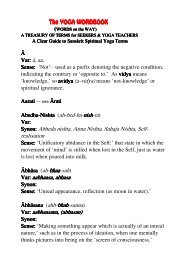Words on the Way - Muz Murray Mantra Yoga Master
Words on the Way - Muz Murray Mantra Yoga Master
Words on the Way - Muz Murray Mantra Yoga Master
Create successful ePaper yourself
Turn your PDF publications into a flip-book with our unique Google optimized e-Paper software.
H—WORDS <strong>on</strong> <strong>the</strong> WAY<br />
Haøsa Hamn-sah) (Hamn<br />
Var: Hamsah, hamsa<br />
Syn<strong>on</strong>: Hamsopasana, Ham’so, hamsa, so’ham<br />
Sense: ‘Sunbird, or mythical celestial goose or swan.’<br />
It is also c<strong>on</strong>sidered as a mantra in <strong>the</strong> ha†ha<br />
ha-yogic practice of<br />
Hamsah or So’ham, when c<strong>on</strong>centrating <strong>on</strong> <strong>the</strong> sound of <strong>the</strong><br />
inbreath and outbreath, utilised as a form of meditati<strong>on</strong>, for stilling<br />
all mental movement and aligning <strong>on</strong>eself with <strong>the</strong> Divine<br />
Absolute (here designated as ‘Hamsa’).<br />
‘Hamsa’ actually means ‘goose’ a migratory bird (a symbol of<br />
<strong>the</strong> Supreme Spirit and migrati<strong>on</strong> of souls), but popularly it is<br />
usually translated as ‘Divine Swan,’ since a goose does not have<br />
great public appeal.<br />
Some schools c<strong>on</strong>sider that <strong>the</strong> whisper of <strong>the</strong> breath entering <strong>the</strong><br />
nostrils makes <strong>the</strong> sound of ‘Saah’ and ‘hamm’ is <strong>the</strong> sound that<br />
occurs <strong>on</strong> <strong>the</strong> outbreath; hence (according to <strong>the</strong> rules of Sanskrit<br />
grammar) <strong>the</strong> combinati<strong>on</strong> of <strong>the</strong>se two sounds are written as<br />
So’ham, and known as Soham mantra. O<strong>the</strong>r schools reverse <strong>the</strong><br />
sounds, taking ‘hammm’ as <strong>the</strong> sound of <strong>the</strong> inbreath, while <strong>the</strong><br />
exhalati<strong>on</strong> makes <strong>the</strong> sound of ‘saaa.’ Therefore it is known as<br />
ei<strong>the</strong>r <strong>the</strong> Hamsa mantra or So’ham mantra; a natural form of<br />
ajapa-japa<br />
(that is, mantra which occurs automatically by itself).<br />
Quotes:<br />
a) The sage Gorakshanath appears to c<strong>on</strong>cur with <strong>the</strong> so’ham style<br />
of breathing, but still calls it hamsa mantra, stating:<br />
“The prana of <strong>the</strong> jiva goes out with ‘ha’ and enters<br />
with <strong>the</strong> sound ‘sah.’ It thus recites <strong>the</strong> mantra ‘hamsahamsa.’<br />
In <strong>on</strong>e night <strong>the</strong> jiva makes 21,600 recitati<strong>on</strong>s<br />
276



